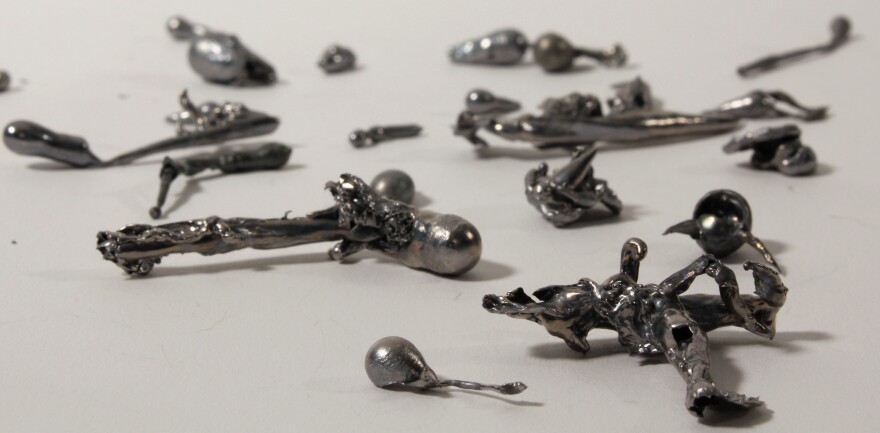As we approach the threshold of a new year, it's only human to wonder what's ahead. In Germany and a few nearby countries, the answer to this age-old existential question is found in molten lead.
When Gesine Krätzner had some scraps of lead left over from a roofing project last winter, she knew just what to do with them. Krätzner lives in Portland, Ore., but grew up in Germany. As a kid, she would melt bits of lead with her family for a New Year's Eve tradition called Bleigiessen.
"We would take a spoon and melt the lead above a candle," she says. "Then you take the molten lead and you pour it into some cold water, and it would ... harden in crazy shapes."
When you look at the shapes, you may get a glimpse into what the future will hold.
"They were all blobs, pretty much. But with a bit of fantasy, you imagine they were hearts, or plants or whatever," Krätzner says.
But why use a candle when you can use a blowtorch? Krätzner, along with her family and a few friends, step outside on a windy Portland night to show how it's done. After their torch melts the lead, each person takes a turn tipping his or her molten spoonful into the tub of water. Maybe it's because it's so cold, but the hardening lead makes more of an explosive pop than a sizzle.
The shapes that result are pretty spectacular, like shiny little abstract sculptures. After you fish them out of the water, it's time to read the future.
"The thrust of the tradition is people joking about the shapes and debating and arguing and laughing over what it might represent," says Peter Tokofsky. "But that really is a playful way of dealing with really big questions."
Tokofsky teaches German culture and folklore at the University of California, Los Angeles, and at The Getty museum. He says that while the practice likely only goes back a few hundred years, the interpretations touch on concerns we've always had around New Year's.
"The themes are the big life themes: love, death, economy. I like this tradition because it's a kind of combination of agency and fate," he says. "So we're the agent — we pour it and we interpret it. But ultimately, one would say that fate is deciding the shape."
And, ultimately, that's what the New Year is about.
"We try to take charge and resolve, fix things that we didn't like about the past year. But life continues, and sometimes we don't control all of those things," Tokofsky says.
While the tradition now is pretty much a game, you have to wonder, did people use to take it seriously? Tokofsky says we don't really know. But also, it doesn't really matter.
"Traditionally, noise-making was believed to scare off demons who are known to be about on transition points," he says. "So it would be similar to asking, if you go out at midnight and bang some pans, or make some noise, or a firecracker or something, you think you're scaring off demons?"
You probably don't. But you'll probably still do it on New Year's Eve. For Krätzner, the lead-pouring tradition means different things at different times. She points to her own father.
"He was 10 years old when the war ended, and he actually has memories of the grown-ups casting the lead and seeing bombs," Krätzner says.
And, as her husband, Mykle Hansen, points out, you never know what'll happen.
"I believe all of these are interesting ways to sort of trick yourself into looking at your own subconscious, because it's hard to look at directly sometimes," he says. "But then again, well, the future will tell, won't it?"
Because after the lead is poured and the fortunes are read, all we can do is wait and see what sort of year unfolds.
Copyright 2022 NPR. To see more, visit https://www.npr.org.





